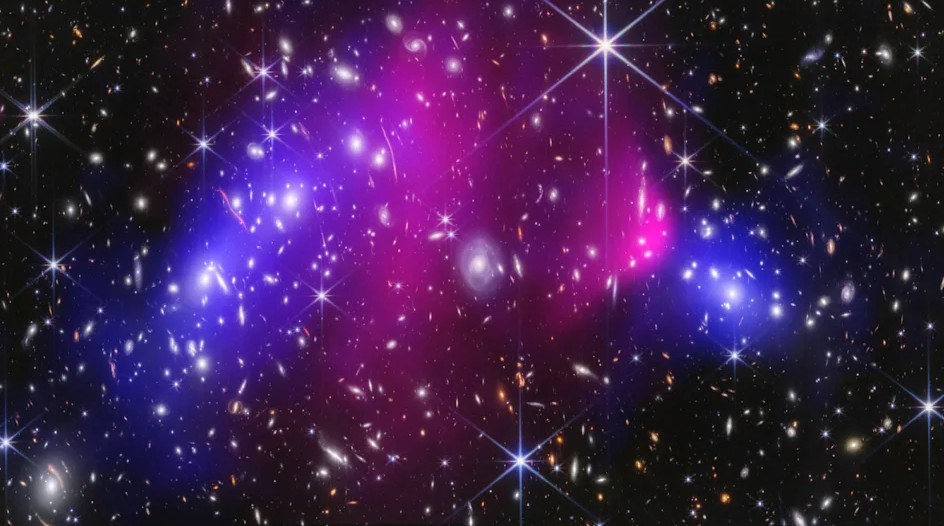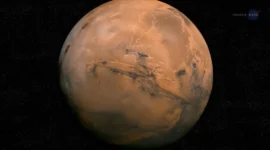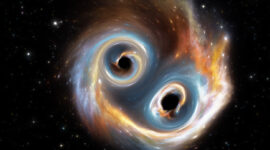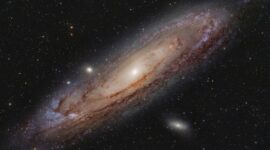July 8, 2025 – 14:30 UTC, the James Webb Space Telescope (JWST) has once again expanded our understanding of the cosmos by capturing a breathtaking image of a titanic collision between galaxy clusters, a phenomenon that reveals the dynamic and often violent nature of the universe. This image, a masterpiece of modern astronomy, showcases the sheer scale and energy involved when massive galactic structures interact, providing scientists with invaluable data to study the forces that shape the universe. Galaxy clusters are the largest gravitationally bound structures in the cosmos, containing hundreds or even thousands of galaxies, vast clouds of hot gas, and enormous amounts of dark matter. When these colossal entities collide, the event is one of the most energetic processes in the universe, releasing staggering amounts of energy that can be observed across multiple wavelengths, from X-rays to radio waves. The JWST’s advanced infrared capabilities allow it to peer through dust and gas that often obscure such events in visible light, offering an unprecedented view of the intricate details and aftermath of these cosmic smash-ups.
A Cosmic Spectacle of Unmatched Scale
The collision captured by JWST is a spectacular example of what happens when two galaxy clusters merge, a process that can take hundreds of millions of years to complete. As the clusters approach each other, drawn together by their immense gravitational pull, the galaxies within them often pass by one another without colliding directly, thanks to the vast distances between individual stars. However, the hot gas permeating the clusters does interact, creating shock waves that heat the gas to temperatures of tens of millions of degrees, causing it to emit X-rays. These shock fronts are visible in the JWST image as bright, filamentary structures, revealing the regions where the gas is being compressed and heated. Meanwhile, the dark matter within the clusters, which does not interact electromagnetically and thus remains invisible, can be detected through its gravitational effects, bending the light from background galaxies in a phenomenon known as gravitational lensing.
Dark Matter’s Ghostly Signature Revealed
One of the most striking features of the JWST image is the way it highlights the separation between the gas and the dark matter in the colliding clusters. This separation is a key prediction of the cold dark matter model, which posits that dark matter interacts only through gravity and not through other forces. As the clusters collide, the gas, which is affected by electromagnetic forces, slows down due to friction and pressure, while the dark matter, unaffected by these forces, continues moving forward. This creates a distinct offset between the two components, a telltale sign that dark matter is indeed a dominant yet invisible presence in the universe. The JWST’s ability to resolve these details with such clarity is a testament to its revolutionary design and the years of scientific effort that went into its development.
Beyond the scientific implications, the image is also a visual marvel, showcasing the beauty and complexity of the universe. The collision has triggered bursts of star formation in some of the galaxies involved, as the gravitational turbulence compresses gas and dust, creating the perfect conditions for new stars to ignite. These star-forming regions glow brightly in the infrared, their light piercing through the surrounding material to be captured by JWST’s sensitive instruments. The image also reveals a tapestry of background galaxies, their light distorted and magnified by the gravitational lensing effect of the massive clusters. These distant galaxies, some of them among the earliest ever observed, provide a glimpse into the universe’s past, allowing astronomers to study the evolution of galaxies over billions of years.
A Laboratory for Extreme Physics
The discovery and analysis of such collisions are crucial for understanding the large-scale structure of the universe. Galaxy clusters are the building blocks of the cosmic web, the vast network of filaments and voids that make up the universe’s architecture. By studying how these clusters form and merge, scientists can gain insights into the distribution of dark matter, the behavior of ordinary matter under extreme conditions, and the fundamental physics governing the cosmos. The JWST’s observations are complemented by data from other telescopes, such as the Chandra X-ray Observatory, which maps the hot gas, and ground-based observatories that measure the gravitational lensing effects. Together, these tools provide a multiwavelength view of the collision, painting a comprehensive picture of the event.
This particular collision may also hold clues to some of the universe’s most enduring mysteries, such as the nature of dark energy, the mysterious force driving the accelerated expansion of the universe. By measuring the growth of galaxy clusters over time, astronomers can test theories about how dark energy influences the formation of large-scale structures. Additionally, the extreme environments created by these collisions are natural laboratories for studying particle acceleration and magnetic fields, which play a role in generating high-energy cosmic rays. The JWST’s ability to observe these phenomena in unprecedented detail opens new avenues for research, potentially leading to breakthroughs in our understanding of fundamental physics.
JWST Continues to Redefine Astronomy
The image also serves as a reminder of the JWST’s transformative impact on astronomy. Since its launch, the telescope has delivered a steady stream of groundbreaking discoveries, from the earliest galaxies to the atmospheres of exoplanets. Its infrared vision allows it to see farther and with greater clarity than any telescope before it, uncovering secrets of the universe that were previously hidden. The collision of galaxy clusters is just one example of how JWST is revolutionizing our view of the cosmos, providing data that will keep scientists busy for years to come. Each new image not only answers existing questions but also raises new ones, driving the cycle of discovery that lies at the heart of scientific progress.
“Every new JWST image challenges our theories and opens new questions,” said Dr. Michael Chen, a cosmologist at NASA’s Jet Propulsion Laboratory. “This collision is just one piece of the puzzle—but it’s a piece that could reshape our understanding of the universe’s structure.”
In the broader context, the study of galaxy cluster collisions underscores the interconnectedness of the universe’s components. The interplay between dark matter, ordinary matter, and energy shapes the evolution of cosmic structures, influencing everything from the formation of galaxies to the fate of the universe itself. The JWST’s observations provide a window into these processes, helping astronomers piece together the story of how the universe came to be as it is today. As the telescope continues its mission, it will undoubtedly capture more such spectacular events, each one adding another piece to the puzzle of cosmic evolution.
Ultimately, the JWST’s image of colliding galaxy clusters is more than just a stunning snapshot; it is a powerful tool for scientific inquiry, a source of inspiration, and a reminder of humanity’s capacity to explore the unknown. The telescope’s success is a testament to the ingenuity and perseverance of the scientists, engineers, and visionaries who made it possible. As we gaze upon this titanic collision, we are reminded of the vastness and dynamism of the universe, and of our own small but significant place within it. The JWST continues to push the boundaries of knowledge, revealing the universe in ways we could only imagine, and inspiring future generations to keep looking up and wondering what else is out there.




